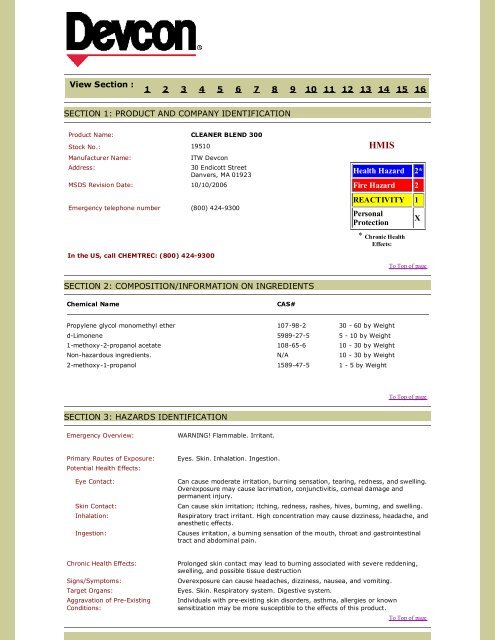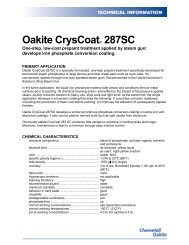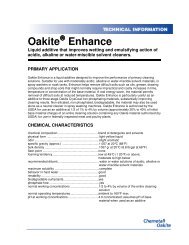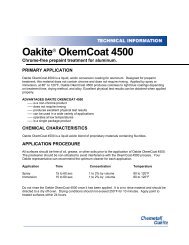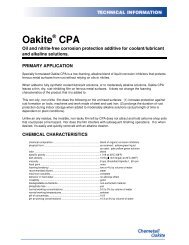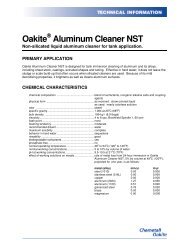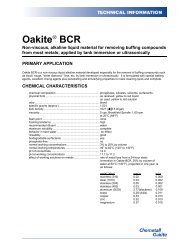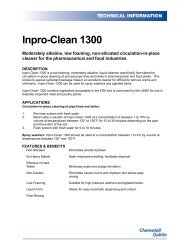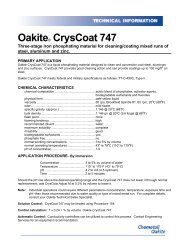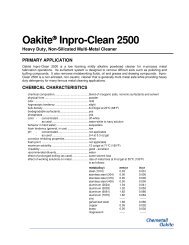Material Safety Data Sheet (MSDS) - Industrial Cleaning Supply
Material Safety Data Sheet (MSDS) - Industrial Cleaning Supply
Material Safety Data Sheet (MSDS) - Industrial Cleaning Supply
- No tags were found...
Create successful ePaper yourself
Turn your PDF publications into a flip-book with our unique Google optimized e-Paper software.
View Section :1 2 3 4 5 6 7 8 9 10 11 12 13 14 15 16SECTION 1: PRODUCT AND COMPANY IDENTIFICATIONProduct Name: CLEANER BLEND 300Stock No.: 19510Manufacturer Name:Address:ITW Devcon30 Endicott StreetDanvers, MA 01923<strong>MSDS</strong> Revision Date: 10/10/2006Emergency telephone number (800) 424-9300HMISHealth Hazard 2*Fire Hazard 2REACTIVITY 1PersonalProtectionX* Chronic HealthEffects:In the US, call CHEMTREC: (800) 424-9300To Top of pageSECTION 2: COMPOSITION/INFORMATION ON INGREDIENTSChemical Name CAS#Propylene glycol monomethyl ether 107-98-2 30 - 60 by Weightd-Limonene 5989-27-5 5 - 10 by Weight1-methoxy-2-propanol acetate 108-65-6 10 - 30 by WeightNon-hazardous ingredients. N/A 10 - 30 by Weight2-methoxy-1-propanol 1589-47-5 1 - 5 by WeightTo Top of pageSECTION 3: HAZARDS IDENTIFICATIONEmergency Overview:WARNING! Flammable. Irritant.Primary Routes of Exposure:Potential Health Effects:Eye Contact:Skin Contact:Inhalation:Ingestion:Eyes. Skin. Inhalation. Ingestion.Can cause moderate irritation, burning sensation, tearing, redness, and swelling.Overexposure may cause lacrimation, conjunctivitis, corneal damage andpermanent injury.Can cause skin irritation; itching, redness, rashes, hives, burning, and swelling.Respiratory tract irritant. High concentration may cause dizziness, headache, andanesthetic effects.Causes irritation, a burning sensation of the mouth, throat and gastrointestinaltract and abdominal pain.Chronic Health Effects:Signs/Symptoms:Target Organs:Aggravation of Pre-ExistingConditions:Prolonged skin contact may lead to burning associated with severe reddening,swelling, and possible tissue destructionOverexposure can cause headaches, dizziness, nausea, and vomiting.Eyes. Skin. Respiratory system. Digestive system.Individuals with pre-existing skin disorders, asthma, allergies or knownsensitization may be more susceptible to the effects of this product.To Top of page
SECTION 4: FIRST AID MEASURESEye Contact:Skin Contact:Inhalation:Ingestion:Other First Aid:Immediately flush eyes with plenty of water for at least 15 to 20 minutes. Ensureadequate flushing of the eyes by separating the eyelids with fingers. Getimmediate medical attention.Immediately wash skin with plenty of soap and water for 15 to 20 minutes, whileremoving contaminated clothing and shoes. Get medical attention if irritationdevelops or persists.If inhaled, remove to fresh air. If not breathing, give artificial respiration or giveoxygen by trained personnel. Seek immediate medical attention.If swallowed, do NOT induce vomiting. Call a physician or poison control centerimmediately. Never give anything by mouth to an unconscious person.Due to possible aspiration into the lungs, DO NOT induce vomiting if ingested.Provide a glass of water to dilute the material in the stomach. If vomiting occursnaturally, have the person lean forward to reduce the risk of aspiration.To Top of pageSECTION 5: FIRE FIGHTING MEASURESFlammable Properties :Flammable.Auto Ignition Temp :Not determined.Flash Point:104°F (40°C)Flash Point Method:Tag closed cup (TCC)Lower Explosive Limit (LEL) 3.0%Upper Explosive Limit (UEL) 12%Extinguishing Media:Use carbon dioxide (CO2) or dry chemical when fighting fires involving thismaterial.Protective Equipment:As in any fire, wear self-contained breathing apparatus pressure-demand,MSHA/NIOSH (approved or equivalent) and full protective gear.Fire Fighting Instructions:Evacuate area of unprotected personnel. Use cold water spray to cool fireexposed containers to minimize risk of rupture. Do not enter confined fire spacewithout full protective gear. If possible, contain fire run-off water.To Top of pageSECTION 6: ACCIDENTAL RELEASE MEASURESPersonal Precautions:Spill Cleanup Measures:Environmental Precautions:Other Precautions:Evacuate area and keep unnecessary and unprotected personnel from enteringthe spill area.Absorb spill with inert material (e,g., dry sand or earth), then place in a chemicalwaste container. Provide ventilation. Collect spill with a non-sparking tool. Placeinto a suitable container for disposal. Clean up spills immediately observingprecautions in the protective equipment section. After removal, flush spill areawith soap and water to remove trace residue.Flammable, eliminate ignition sources. Vapors can form an ignitable mixture withair. Vapors can flow along surfaces to distant ignition sources and flash back.Ventilate area. Use proper personal protective equipment as listed in section 8.Avoid runoff into storm sewers, ditches, and waterways.Pump or shovel to storage/salvage vessels.To Top of pageSECTION 7: HANDLING AND STORAGEHandling:Storage:Hygiene Practices:Special Handling Procedures:Use with adequate ventilation. Avoid breathing vapor, aerosol or mist. <strong>Material</strong>will accumulate static charges which may cause an electrical spark (ignitionsource). Use proper grounding procedures. Do not reuse containers withoutproper cleaning or reconditioning.Store in a cool, dry, well ventilated area away from sources of heat, combustiblematerials, direct sunlight, and incompatible substances. Keep container tightlyclosed when not in use.Wash thoroughly after handling.Hazardous liquid or vapor residue may remain in emptied container. Do notreuse, heat, burn, pressurize, cut, weld, braze, solder, drill, grind, expose tosparks, flame, or ignition sources of empty containers without proper commercialcleaning or reconditioning.To Top of pageSECTION 8: EXPOSURE CONTROLS, PERSONAL PROTECTIONEngineering Controls:Use appropriate engineering control such as process enclosures, local exhaustventilation, or other engineering controls to control airborne levels belowrecommended exposure limits. Good general ventilation should be sufficient tocontrol airborne levels. Where such systems are not effective wear suitablepersonal protective equipment, which performs satisfactorily and meets OSHA or
Skin Protection Description:Eye/Face Protection:Respiratory Protection:other recognized standards. Consult with local procedures for selection, training,inspection and maintenance of the personal protective equipment.Wear appropriate protective gloves and other protective apparel to prevent skincontact. Consult manufacturer's data for permeability data.Wear appropriate protective glasses or splash goggles as described by 29 CFR1910.133, OSHA eye and face protection regulation, or the European standardEN 166.A NIOSH approved air-purifying respirator with an organic vapor cartridge orcanister may be permissible under certain circumstances where airborneconcentrations are expected to exceed exposure limits. Protection provided byair purifying respirators is limited. Use a positive pressure air supplied respiratorif there is any potential for an uncontrolled release, exposure levels are notknown, or any other circumstances where air purifying respirators may notprovide adequate protection.Other Protective:Facilities storing or utilizing this material should be equipped with an eyewashand a deluge shower safety station.Propylene glycol monomethyl ether:Guideline ACGIH :ACGIH TLV-TWA 100 ppmNotes :Only established PEL and TLV values for the ingredients are listed below.To Top of pageSECTION 9: PHYSICAL AND CHEMICAL PROPERTIESPhysical State/Appearance: Liquid.Color:Pale amberOdor:Ethereal.Boiling Point:212°F (100°C) initialMelting / Freezing Point :Not determined.Solubility:Appreciable.Specific Gravity: 0.95pH:Not determined.Vapor Density: >1 (air = 1)Vapor Pressure:12 mmHg @68°FMolecular Formula:MixtureMolecular Weight:MixturePercent Volatile: 100VOC <strong>Data</strong> :840 g/LPercent Solids by Weight 0To Top of pageSECTION 10: STABILITY AND REACTIVITYChemical Stability:Conditions to Avoid:Incompatibilities with Other<strong>Material</strong>s:Hazardous Polymerization:Stable under normal temperatures and pressures.Extreme heat, sparks, and open flame. Incompatible materials, oxidizers andoxidizing conditions.Oxidizing agents. Strong acids and alkalis.Not reported.To Top of pageSECTION 11: TOXICOLOGICAL INFORMATIONPropylene glycol monomethyl ether:Eye Effect:Eye - Rabbit Standard Draize Test: 500 mg/24H - [mild](RTECS)Skin Effects:Skin - Rabbit Open irritation test -: 500 mg - [mild](RTECS)Skin - Rabbit LD50: 13 gm/kg - [Details of toxic effects not reported other thanlethal dose value](RTECS)Inhalation Effects:Inhalation - Rat LC50: 10000 ppm/5H - [Details of toxic effects not reportedother than lethal dose value] (RTECS)Ingestion Effects: Oral - Rat LD50: 6600 mg/kg - [Brain and Coverings - other rat changes oral -general anesthetic Lungs, Thorax, or rat - dyspnea] (RTECS)Oral - Mouse LD50: 11700 mg/kg - [oral - convulsions or effect on seizurethreshold oral - ataxia Lungs, Thorax, or rat - dyspnea] (RTECS)d-Limonene:Skin Effects:Skin - Rabbit Standard Draize Test: 10 %/24H - [mild ](RTECS)Skin - Rabbit LD50: >5 gm/kg - [Details of toxic effects not reported other thanlethal dose value ](RTECS)Skin - Mammal species unspecified LD50: >5 gm/kg - [Details of toxic effectsnot reported other than lethal dose value ](RTECS)Ingestion Effects:Oral - Rat LD50: 4400 mg/kg - [oral - changes in motor activity (specific assay)Lungs, Thorax, or rat - rat depression Skin and Appendages - hair ] (RTECS)
Oral - Mouse LD50: 5600 mg/kg - [oral - changes in motor activity (specificassay) Lungs, Thorax, or rat - rat depression Skin and Appendages - hair ](RTECS)1-methoxy-2-propanol acetate:Skin Effects:Ingestion Effects:Skin - Rabbit LD50: >5 gm/kg - [Details of toxic effects not reported other thanlethal dose value ](RTECS)Oral - Rat LD50: 8532 mg/kg - [Details of toxic effects not reported other thanlethal dose value ] (RTECS)To Top of pageSECTION 12: ECOLOGICAL INFORMATIONEcotoxicity:Environmental Fate:No ecotoxicity data was found for the product.No environmental information found for this product.To Top of pageSECTION 13: DISPOSAL CONSIDERATIONSWaste Disposal:RCRA Number :Important Disposal Information:Consult with the US EPA Guidelines listed in 40 CFR Part 261.3 for theclassifications of hazardous waste prior to disposal. Furthermore, consult withyour state and local waste requirements or guidelines, if applicable, to ensurecompliance. Arrange disposal in accordance to the EPA and/or state and localguidelines.D001DANGER! Rags, steel wool and waste soaked with this product mayspontaneously catch fire if improperly discarded or stored. To avoid aspontaneous combustion fire, immediately after use, place rags, steel wool orwaste in a sealed, water-filled, metal conTo Top of pageSECTION 14: TRANSPORT INFORMATIONDOT Shipping Name:Flammable liquids, n.o.s.DOT UN Number: 1993DOT Hazard Class: 3DOT Packing Group:IIIIATA Shipping Name:Flammable liquid, n.o.s. (Propylene Glycol Monomethyl Ether), 3, UN 1993, PGIII, ERG 128To Top of pageSECTION 15: REGULATORY INFORMATIONWHMIS PictogramsPropylene glycol monomethyl ether:State:Listed in the State of Massachusetts Hazardous Substance List.Listed in the Pennsylvania State Hazardous Substances List.EC Num : 603-064-00-31-methoxy-2-propanol acetate:EC Num : 607-195-00-7Canadian Regulations.WHMIS Hazard Class(es): B3; D2BAll components of this product are on the Canadian Domestic Substances List.To Top of pageSECTION 16: ADDITIONAL INFORMATIONHMIS Health Hazard: 2*HMIS Fire Hazard: 2HMIS Reactivity: 1HMIS Personal Protection: X<strong>MSDS</strong> Revision Date: 10/10/2006Disclaimer:"This Health and <strong>Safety</strong> Information is correct to the best of our knowledge andbelief at the date of its publication but we cannot accept liability for any loss,injury or damage which may result from its use. The information given in the<strong>Data</strong> <strong>Sheet</strong> is designed only as a guidance for safe handling, storage and the useof the substance. It is not a specification nor does it guarantee any specific
properties. All chemicals should be handled only by competent personnel, withina controlled environment."Copyright© 1996-2007 Actio Software Corporation. All Rights Reserved.


